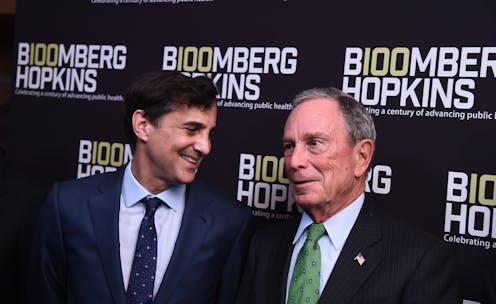Alumni gratitude and support for causes are behind donations of $50 million or more to colleges and universities
- Written by Michael Worth, Professor of Nonprofit Management, George Washington University

The Research Brief[1] is a short take about interesting academic work.
The big idea
The top motive people cite for their donations of US$50 million or more to colleges or universities[2] was a desire to repay a university for what they or a loved one had gotten out of attending, according to a study we published last year. The second two most common reasons were an effort to simply do what they believe is the right thing and a wish to support a particular cause or political agenda.
We found this out when we researched the motives of 30 of these higher education megadonors, through random sampling, from 2010 to 2018 and reviewing about 1,700 publicly available documents and news items that discussed their gifts, including some that quoted the donors themselves. Many donors mentioned more than one motive when they explained why they gave so much money to a school.
Why it matters
Two-thirds of U.S. universities[3] saw their donations decline in 2020 due to a drop in high-dollar gifts, according to a recent survey. Higher ed giving totaled just under $50 billion[4] for the year, as it also did in 2019.
Even some donors who kept giving to universities as the COVID-19 pandemic got underway changed their focus. Data collected by the Council for Advancement and Support of Education suggests that during the 2019-2020 school year, major donors increased their emphasis on giving immediate relief to students, rather than, say, funding the construction of new buildings or adding to a school’s endowment[5].
To be sure, smaller gifts do add up and are important to expanding a school’s pool of donors. And many institutions are working hard to increase them. But the percentage of alumni giving to their alma maters is falling[6], making the largest gifts even more crucial for higher ed fundraising.
A rule of thumb for colleges and universities is that about 5% of donors account for 95% of all giving[7]. Understanding what motivates big donors to support colleges and universities could help those schools become more persuasive when they encourage wealthy people to give.
In some cases, big donors are supporting higher education to advance a broader philanthropic strategy. In 2018, the billionaire Michael Bloomberg gave $1.8 billion to Johns Hopkins[8], his alma mater, to help low-income students.
A more recent example is MacKenzie Scott[9], who divorced Jeff Bezos in 2019 and has become one of the most significant donors in America.
Scott, who earned her college degree from Princeton[10], has disclosed donations to 42 colleges and universities in 2020 totaling more than $800 million. This list includes many historically Black colleges and universities[11] and other schools serving Latino and Native American students, such as Spelman College in Atlanta, Voorhees College in rural South Carolina and Palo Alto College in San Antonio.
But Scott’s giving occurred after we’d completed our study, which we published in the March/April 2020 issue of Public Administration Review[12].
What still isn’t known
In recent years, big donations slated to help students afford a college education[13] accounted for only 13% of all gifts to higher education overall. It’s unclear whether that’s going to change in the long term[14], but, at least during the COVID-19 pandemic, this approach seems to be becoming more common.
In early 2021, retired UPS executive Calvin Tyler and his wife Tina Tyler[15] gave $20 million to Morgan State University[16], the historically Black university he attended in Baltimore, for scholarships. Jerry Richardson[17], who made a fortune with fast food franchises and was the founding owner of the Carolina Panthers football team, gave $150 million to Wofford College[18], the South Carolina liberal arts school he attended in the 1950s, for scholarships and other student support.
Only time will tell whether the trend toward more multimillion-dollar gifts that directly help students will continue or whether the traditional focus on gifts for endowments and buildings will return once the COVID-19 pandemic ends.
[Insight, in your inbox each day. You can get it with The Conversation’s email newsletter[19].]
References
- ^ Research Brief (theconversation.com)
- ^ donations of US$50 million or more to colleges or universities (doi.org)
- ^ Two-thirds of U.S. universities (www.philanthropy.com)
- ^ Higher ed giving totaled just under $50 billion (www.insidehighered.com)
- ^ new buildings or adding to a school’s endowment (www.case.org)
- ^ percentage of alumni giving to their alma maters is falling (www.hanoverresearch.com)
- ^ 5% of donors account for 95% of all giving (eab.com)
- ^ Michael Bloomberg gave $1.8 billion to Johns Hopkins (www.insidehighered.com)
- ^ MacKenzie Scott (theconversation.com)
- ^ earned her college degree from Princeton (paw.princeton.edu)
- ^ historically Black colleges and universities (www.washingtonpost.com)
- ^ Public Administration Review (doi.org)
- ^ big donations slated to help students afford a college education (www.tiaainstitute.org)
- ^ unclear whether that’s going to change in the long term (www.insidephilanthropy.com)
- ^ Calvin Tyler and his wife Tina Tyler (abc7ny.com)
- ^ $20 million to Morgan State University (www.cnn.com)
- ^ Jerry Richardson (www.sportscasting.com)
- ^ gave $150 million to Wofford College (www.greenvillebusinessmag.com)
- ^ You can get it with The Conversation’s email newsletter (theconversation.com)
Authors: Michael Worth, Professor of Nonprofit Management, George Washington University

